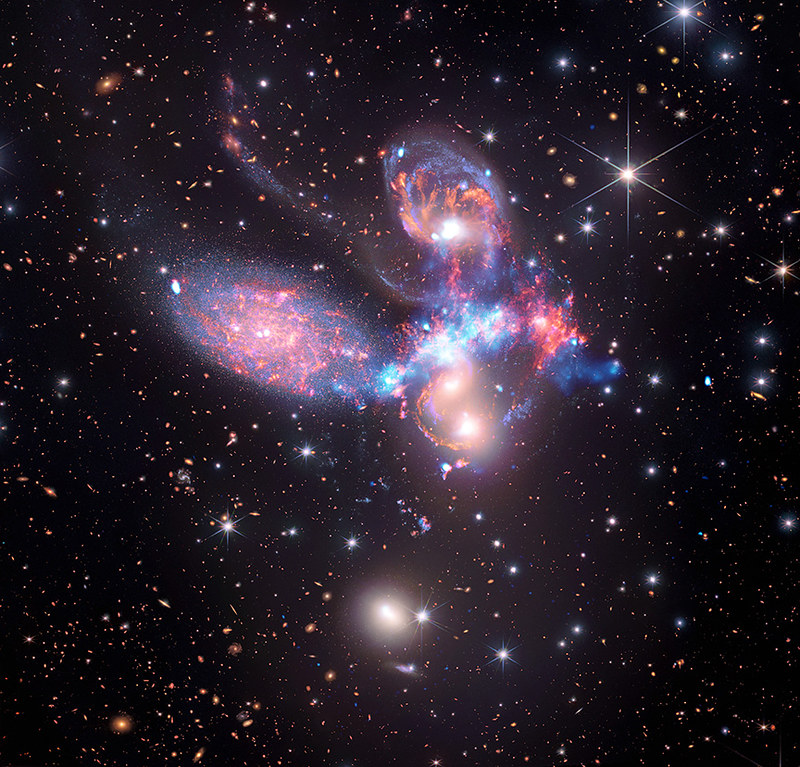#Chandra X-ray Observatory
Explore tagged Tumblr posts
Video
O Christmas Tree! by NASA's Marshall Space Flight Center Via Flickr: A new version of the “Christmas tree cluster” is now available. Like NGC 602, NGC 2264 is a cluster of young stars between one and five million years old. (For comparison, the Sun is a middle-aged star about 5 billion years old — about 1,000 times older.) In this image of NGC 2264, which is much closer than NGC 602 at a distance of about 2,500 light-years from Earth, data from NASA's Chandra X-ray Observatory (red, purple, blue, and white) has been combined with optical data (green and violet) captured from by astrophotographer Michael Clow from his telescope in Arizona in November 2024. Credit: X-ray: NASA/CXC/SAO; Optical: Clow, M.; Image Processing: NASA/CXC/SAO/L. Frattare and K. Arcand #NASAMarshall #NASA #astrophysics #NASAChandra #NASA #JWST #NASAWebb #star #starcluster Read more Read more about the Chandra X-ray Observatory NASA Media Usage Guidelines
#NASA#NASA's Marshall Space Flight Center#NASA Marshall#Marshall#MSFC#Solar System & Beyond#astronomy#astrophysics#Chandra X-Ray Observatory#star#star cluster#flickr
101 notes
·
View notes
Text
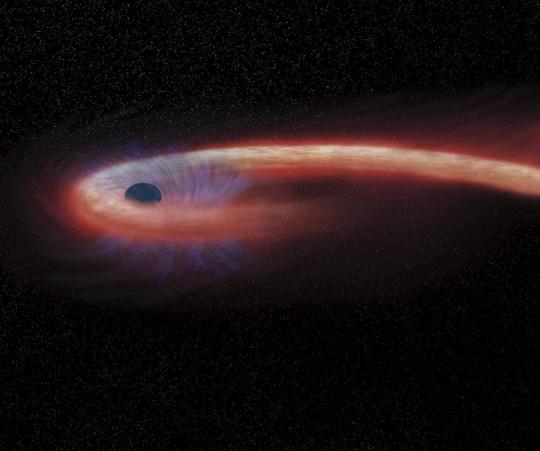
Black holes use gravity to pull matter into them.
NASA/Chandra X-ray Observatory/M.Weiss via AP
103 notes
·
View notes
Text

The Star Cluster NGC 602
A image of star cluster NGC 602 from Chandra & NASAWebb is about 175 light-years across and it sparkles with the light from thousands of stars.
The star cluster NGC 602 lies on the outskirts of the Small Magellanic Cloud, which is one of the closest galaxies to the Milky Way, about 200,000 light-years from Earth. The stars in NGC 602 have fewer heavier elements compared to the Sun and most of the rest of the galaxy. Instead, the conditions within NGC 602 mimic those for stars found billions of years ago when the universe was much younger.
This new image combines data from NASA’s Chandra X-ray Observatory with a previously released image from the agency’s James Webb Space Telescope. The dark ring-like outline of the wreath seen in Webb data (represented as orange, yellow, green, and blue) is made up of dense clouds of filled dust.
Credit X-ray: NASA/CXC; Infrared: ESA/Webb, NASA & CSA, P. Zeilder, E.Sabbi, A. Nota, M. Zamani;
Image Processing: NASA/CXC/SAO/L. Frattare and K. Arcand.
Release Date December 17, 2024.
#The Star Cluster NGC 602#James Webb Space Telescope#Chandra X-ray Observatory#nasa#nasa photos#nasa picture of the day#spacee#space exploration#outer space
36 notes
·
View notes
Text
Scientists have discovered the oldest black hole yet, a cosmic beast formed a mere 470 million years after the Big Bang. The findings, published Monday, confirm what until now were theories that supermassive black holes existed at the dawn of the universe. NASA's James Webb Space Telescope and Chandra X-Ray Observatory teamed up over the past year to make the observations. Given the universe is 13.7 billion years old, that puts the age of this black hole at 13.2 billion years. Even more astounding to scientists, this black hole is a whopper—10 times bigger than the black hole in our own Milky Way.
Continue Reading.
174 notes
·
View notes
Text

"This new image of NGC 2264, also known as the 'Christmas Tree Cluster,' shows the shape of a cosmic tree with the glow of stellar lights. NGC 2264 is, in fact, a cluster of young stars — with ages between about one and five million years old — in our Milky Way about 2,500 light-years away from Earth. The stars in NGC 2264 are both smaller and larger than the Sun, ranging from some with less than a tenth the mass of the Sun to others containing about seven solar masses.
This new composite image enhances the resemblance to a Christmas tree through choices of color and rotation. The blue and white lights (which blink in the animated version of this image) are young stars that give off X-rays detected by NASA’s Chandra X-ray Observatory. Optical data from the National Science Foundation’s WIYN 0.9-meter telescope on Kitt Peak shows gas in the nebula in green, corresponding to the 'pine needles' of the tree, and infrared data from the Two Micron All Sky Survey shows foreground and background stars in white. This image has been rotated clockwise by about 160 degrees from the astronomer’s standard of North pointing upward, so that it appears like the top of the tree is toward the top of the image.

Young stars, like those in NGC 2264, are volatile and undergo strong flares in X-rays and other types of variations seen in different types of light. The coordinated, blinking variations shown in this animation, however, are artificial, to emphasize the locations of the stars seen in X-rays and highlight the similarity of this object to a Christmas tree. In reality the variations of the stars are not synchronized.
The variations observed by Chandra and other telescopes are caused by several different processes. Some of these are related to activity involving magnetic fields, including flares like those undergone by the Sun — but much more powerful — and hot spots and dark regions on the surfaces of the stars that go in and out of view as the stars rotate. There can also be changes in the thickness of gas obscuring the stars, and changes in the amount of material still falling onto the stars from disks of surrounding gas.
NASA’s Marshall Space Flight Center manages the Chandra program. The Smithsonian Astrophysical Observatory’s Chandra X-ray Center controls science operations from Cambridge, Massachusetts, and flight operations from Burlington, Massachusetts."
Date: December 19, 2023
NASA ID: link
#NGC 2264#Christmas Tree Cluster#Space#Galaxy#NASA#December#2023#gif#Chandra X-ray Observatory#X-ray Observatory#Chandra#Marshall Space Flight Center#MSFC#Huntsville#Alabama#my post
87 notes
·
View notes
Text



24 December 2023
💚🎄💚
#NASA#Christmas Tree Cluster#Christmas Tree#stars#space#galaxy#universe#cosmos#Christmas#Christmas Eve#Chandra X-ray Observatory#space telescope#space observatory#X-ray astronomy
36 notes
·
View notes
Text
The Christmas Tree Cluster
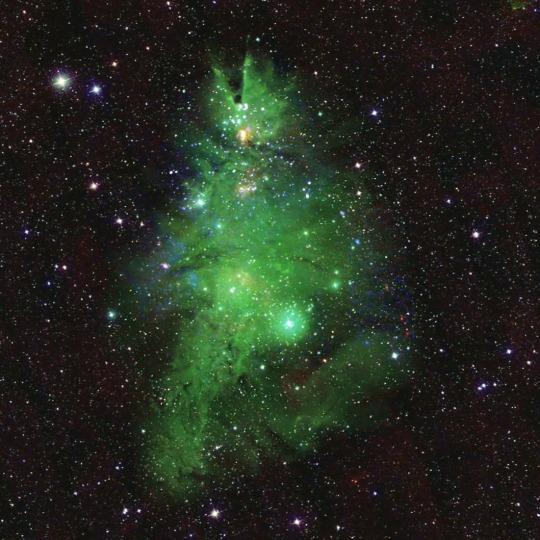
About 2,500 light-years from Earth, this community of young stars (less than 5 million years old - our middle-aged Sun has been burning for more than 5 billion years) give off X-rays that help light up the green nebula surrounding them, giving this cluster (NGC 2264) its nickname.
18 notes
·
View notes
Text
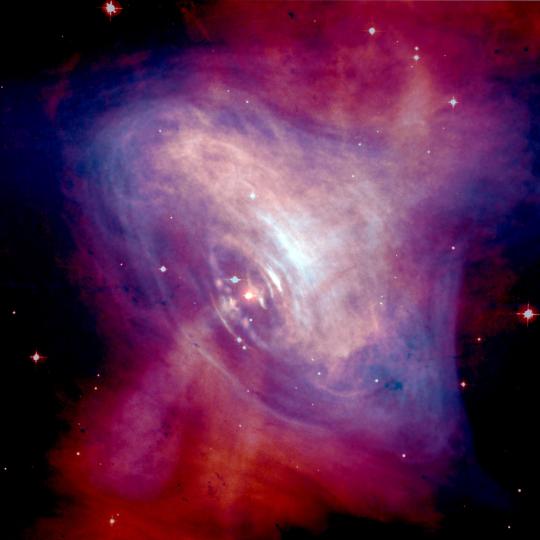
Púlsar de la Nebulosa del Cangrejo. Imágenes combinadas procedentes del Telescopio Espacial Hubble (en rojo) y del Observatorio de Rayos X Chandra (en azul).
#astronomy#space#pulsar#neutron star#crab nebula#supernova#crab pulsar#hubble#chandra#hubble space telescope#chandra x-ray observatory#astronomía#espacio#nebulosa del cangrejo#púlsar#telescopio espacial hubble#observatorio de rayos-x chandra#estrella de neutrones
11 notes
·
View notes
Text
Record-Smashing Black Hole Born in Universe’s Infancy - Technology Org
New Post has been published on https://thedigitalinsider.com/record-smashing-black-hole-born-in-universes-infancy-technology-org/
Record-Smashing Black Hole Born in Universe’s Infancy - Technology Org
An international team of astrophysicists, including Princeton’s Andy Goulding has discovered the most distant supermassive black hole ever found, using two NASA space telescopes: the Chandra X-ray Observatory (Chandra) and the James Webb Space Telescope (JWST).
Astrophysicists combined data from JWST and the Chandra X-ray Observatory to identify the growing black hole at the center of this image. Image credit: X-ray: NASA/CXC/SAO/Ákos Bogdán et al.; Infrared: NASA/ESA/CSA/STScI; Image processing: NASA/CXC/SAO/L. Frattare, K. Arcand
The black hole, which is an estimated 10 to 100 million times more massive than our sun, is 13.2 billion light-years away in the galaxy UHZ-1, which means the telescopes are peering back in time to when the universe was “extremely young,” Goulding said — only about 450 million years old.
“This is one of the most dramatic discoveries to come out of the James Webb Space Telescope” and the discovery of the most distant growing supermassive black hole known, said Michael Strauss, professor and chair of astrophysical sciences at Princeton, who discussed the findings with the researchers but was not part of the research team. “Indeed, it completely smashes the old record.”
Precisely how the first black holes were formed in the universe’s infancy has been a long-standing debate among astronomers.
“Now, finally discovering a black hole that was so large, when the universe was so young, tells us that the black hole must have been very large when it was initially formed, probably from the direct collapse of a massive gas cloud,” said Goulding, who is a research scientist in Princeton’s Department of Astrophysical Sciences.
It also means that astronomers can rule out other formation models, like the death of the first massive stars, because those couldn’t produce a black hole large enough to explain UHZ-1, he added.
“The black hole has only a very short time to grow,” he said. “It either grew extraordinarily fast or the black hole was simply born larger.”
Goulding is one of the lead authors of the primary paper announcing the result and the lead author of a separate paper in The Astrophysical Journal Letters detailing the mass of the galaxy and its extraordinary distance, which was pivotal to the overall result.
Different telescopes have different tools to peer into the universe, and combining data from multiple instruments can yield more than a sum of their parts. “We needed Webb to find this remarkably distant galaxy and Chandra to find its supermassive black hole,” said Ákos Bogdán of the Center for Astrophysics-Harvard & Smithsonian in the press release. Bogdan is first author on the Nature Astronomy paper.
Written by Liz Fuller-Wright
Source: Princeton University
You can offer your link to a page which is relevant to the topic of this post.
#amp#Astronomy#Astronomy news#Astrophysics#billion#black hole#Black holes#Born#Chandra X-ray Observatory#Cloud#data#Discoveries#ESA#Featured Space news#Fundamental physics news#Galaxy#gas#how#indeed#international team#it#James Webb Space Telescope#jwst#Light#Link#mass#NASA#nature#One#Other
2 notes
·
View notes
Text
The Sun creates enormous sound waves through its constant churning of plasma and fusion reactions. These waves are essentially pressure oscillations that travel through the Sun's plasma. Scientists call these oscillations "solar oscillations" or "helioseismic waves."
The "sound" these oscillations would make, if we could hear them, would be far below the range of human hearing - around 3 mHz (millihertz), or about 0.003 Hz. For comparison, humans generally hear between 20 Hz and 20,000 Hz.
The reason we can't hear these sounds on Earth is simple: sound waves need a medium to travel through (like air or water), and space is essentially a vacuum. There's no medium for the sound to travel from the Sun to Earth.
However, scientists have found ways to "listen" to the Sun:
NASA and other space agencies have converted the Sun's vibrations and electromagnetic variations into audible frequencies. This process is called "sonification" - it's not actual sound, but rather data converted into sound we can hear.
These solar "sounds" often come out as eerie humming or pulsing noises. The Sun essentially "rings" like a bell, but at frequencies millions of times deeper than we can hear.
The study of these solar oscillations (helioseismology) is actually quite important - it helps scientists understand the Sun's internal structure and dynamics, much like how seismology helps us understand Earth's interior.
I watched a video on sonification with astrophysicist and data sonification expert Kimberly Arcand the other day via StarTalk. It's over an hour long but worth the watch! They also mention Wanda Díaz-Merced, a blind astronomer who pioneered the use of sonification to study visual data! https://www.youtube.com/watch?v=sSl3bHuls80

#very cool#sun#solar#vacuum of space#nasa#sonification#jwst#Chandra X-Ray Observatory#data#no but you don't understand how much i love women in science#and when others use their platform to share their knowledge with us
7K notes
·
View notes
Video
Eccentric ‘Star’ Defies Easy Explanation, NASA’s Chandra Finds by NASA's Marshall Space Flight Center Via Flickr: Scientists have discovered a star behaving like no other seen before, giving fresh clues about the origin of a new class of mysterious objects. This composite image features a mysterious object, possibly an unusual neutron star or white dwarf, residing near the edge of a supernova remnant. The object, known as ASKAP J1832, has been intriguing astronomers from the Chandra X-ray Observatory and Square Kilometre Array Pathfinder radio telescope with its antics and bizarre behavior. Astronomers have discovered that ASKAP J1832 cycles in radio wave intensity every 44 minutes. This is thousands of times longer than pulsars, which are rapidly spinning neutron stars that have repeated variations multiple times a second. Using Chandra, the team discovered that the object is also regularly varying in X-rays every 44 minutes. This is the first time such an X-ray signal has been found in a long period radio transient like ASKAP J1832. Credit: X-ray: NASA/CXC/ICRAR, Curtin Univ./Z. Wang et al.; Infrared: NASA/JPL/CalTech/IPAC; Radio: SARAO/MeerKAT; Image processing: NASA/CXC/SAO/N. Wolk #NASAMarshall #NASA #astrophysics #NASAChandra #Space #Chandra #Telescope #Universe #LongPeriodRadioTransients Listen to all three sonifications Read more about the Chandra X-ray Observatory NASA Media Usage Guidelines
#NASA#NASA's Marshall Space Flight Center#NASA Marshall#Marshall#MSFC#Solar System & Beyond#astronomy#astrophysics#Chandra X-Ray Observatory#long period radio transients#flickr
9 notes
·
View notes
Text
The triumph of ignorance. How does dark-age thinking threaten our existence?
“Dark-age thinking” lacks imagination. It is anti-science, anti-art, and anti-exploration. It assures a lack of human progress because it can’t imagine what human progress looks like. A hundred years ago, it would not have imagined the Internet, smart watches, smart phones, jet planes, GPS, supercomputers, 3-D printing, robotic surgery, antibiotics, genome editing, CRISPR, transistors, solar…
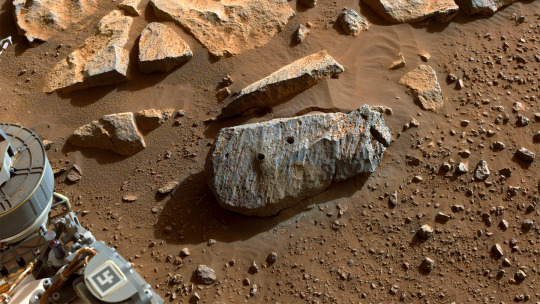
View On WordPress
#Alpha Magnetic Spectrometer#Chandra X-ray Observatory#dark-age thinking#Jet Propulsion Laboratory#monetary sovereignty
0 notes
Link
X-ray: (Chandra) NASA/CXC/U. Manitoba/C. Treyturik, (XMM-Newton) ESA/C. Treyturik; Optical: (Pan-STA...
0 notes
Text
AXIS mission selected as NASA Astrophysics Probe competition finalist
New Post has been published on https://thedigitalinsider.com/axis-mission-selected-as-nasa-astrophysics-probe-competition-finalist/
AXIS mission selected as NASA Astrophysics Probe competition finalist


The MIT Kavli Institute for Astrophysics and Space Research (MKI) is a project lead for one of two finalist missions recently selected for NASA’s new Probe Explorers program. Working with collaborators at the University of Maryland and Goddard Space Flight Research Center, the team will produce a one-year concept study to launch the Advanced X-ray Imaging Satellite (AXIS) in 2032.
Erin Kara, associate professor of physics and astrophysicist at MIT, is the deputy principal investigator for AXIS. The MIT team includes MKI scientists Eric Miller, Mark Bautz, Catherine Grant, Michael McDonald, and Kevin Burdge. Says Kara, “I am honored to be working with this amazing team in ushering in a new era for X-ray astronomy.”
The AXIS mission is designed to revolutionize the view scientists have of high-energy events and environments in the universe using new technologies capable of seeing even deeper into space and further back in time.
“If selected to move forward,” explains Kara, “AXIS will answer some of the biggest mysteries in modern astrophysics, from the formation of supermassive black holes to the progenitors of the most energetic and explosive events in the universe to the effects of stars on exoplanets. Simply put, it’s the next-generation observatory we need to transform our understanding of the universe.”
Critical to AXIS’s success is the CCD focal plane — an array of imaging devices that record the properties of the light coming into the telescope. If selected, MKI scientists will work with colleagues at MIT Lincoln Laboratory and Stanford University to develop this high-speed camera, which sits at the heart of the telescope, connected to the X-ray Mirror Assembly and telescope tube. The work to create the array builds on previous imaging technology developed by MKI and Lincoln Laboratory, including instruments flying on the Chandra X-ray Observatory, the Suzaku X-ray Observatory, and the Transiting Exoplanet Survey Satellite (TESS).
Camera lead Eric Miller notes that “the advanced detectors that we will use provide the same excellent sensitivity as previous instruments, but operating up to 100 times faster to keep up with all of the X-rays focused by the mirror.” As such, the development of the CCD focal plane will have significant impact in both scientific and technological realms.
“Engineering the array over the next year,” adds Kara, “will lay the groundwork not just for AXIS, but for future missions as well.”
#amazing#Astronomy#Astronomy and astrophysics#Astrophysics#Black holes#Chandra X-ray Observatory#Collaboration#competition#development#devices#effects#energy#engineering#Events#exoplanet#Exoplanets#flight#Future#heart#Imaging#impact#it#Kavli Institute#Light#Lincoln Laboratory#mit#NASA#notes#One#Physics
0 notes
Text
The five galaxies of Stephan's Quintet, a composite of imagery from JWST and the Chandra X-Ray Observatory.
#nasa#space program#astrophotography#astronomy#jwst#james webb space telescope#chandra x ray observatory
267 notes
·
View notes
Text

The large barred spiral galaxy NGC 6872 is interacting with a smaller galaxy to its upper left in this composite image built from Hubble Space Telescope and Chandra X-ray Observatory data.
The smaller galaxy has likely stripped gas from NGC 6872, which feeds the supermassive black hole in its center. The X-ray data from Chandra can be seen in purple, while the visible data from Hubble is red, green, and blue.
Credit: X-ray: NASA/CXC/SAO; Visible: NASA/ESA/STScI; Image Processing: NASA/CXC/SAO/J. Schmidt, L. Frattare, and J. Major.
#space#astronomy#science#stsci#universe#nasa#hubble#hubble space telescope#hubble image#chandra#chandra x ray observatory#xray#galaxy
255 notes
·
View notes


